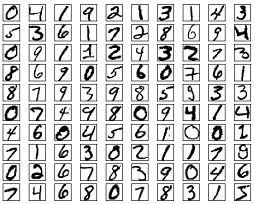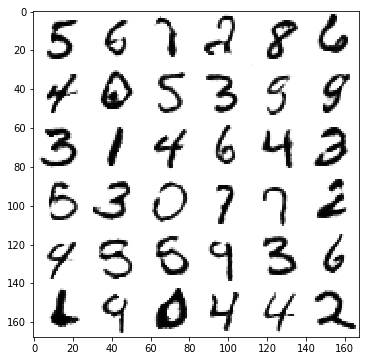Deep Convolutional Generative Adversarial Network Example
Build a deep convolutional generative adversarial network (DCGAN) to generate digit images from a noise distribution with TensorFlow.
- Author: Aymeric Damien
- Project: https://github.com/aymericdamien/TensorFlow-Examples/
DCGAN Overview
References:
- Unsupervised representation learning with deep convolutional generative adversarial networks. A Radford, L Metz, S Chintala, 2016.
- Understanding the difficulty of training deep feedforward neural networks. X Glorot, Y Bengio. Aistats 9, 249-256
- Batch Normalization: Accelerating Deep Network Training by Reducing Internal Covariate Shift. Sergey Ioffe, Christian Szegedy. 2015.
MNIST Dataset Overview
This example is using MNIST handwritten digits. The dataset contains 60,000 examples for training and 10,000 examples for testing. The digits have been size-normalized and centered in a fixed-size image (28x28 pixels) with values from 0 to 1. For simplicity, each image has been flattened and converted to a 1-D numpy array of 784 features (28*28).

More info: http://yann.lecun.com/exdb/mnist/
from __future__ import division, print_function, absolute_import
import matplotlib.pyplot as plt
import numpy as np
import tensorflow as tf
# Import MNIST data
from tensorflow.examples.tutorials.mnist import input_data
mnist = input_data.read_data_sets("/tmp/data/", one_hot=True)
Extracting /tmp/data/train-images-idx3-ubyte.gz
Extracting /tmp/data/train-labels-idx1-ubyte.gz
Extracting /tmp/data/t10k-images-idx3-ubyte.gz
Extracting /tmp/data/t10k-labels-idx1-ubyte.gz
# Training Params
num_steps = 10000
batch_size = 128
lr_generator = 0.002
lr_discriminator = 0.002
# Network Params
image_dim = 784 # 28*28 pixels * 1 channel
noise_dim = 100 # Noise data points
# Build Networks
# Network Inputs
noise_input = tf.placeholder(tf.float32, shape=[None, noise_dim])
real_image_input = tf.placeholder(tf.float32, shape=[None, 28, 28, 1])
# A boolean to indicate batch normalization if it is training or inference time
is_training = tf.placeholder(tf.bool)
#LeakyReLU activation
def leakyrelu(x, alpha=0.2):
return 0.5 * (1 + alpha) * x + 0.5 * (1 - alpha) * abs(x)
# Generator Network
# Input: Noise, Output: Image
# Note that batch normalization has different behavior at training and inference time,
# we then use a placeholder to indicates the layer if we are training or not.
def generator(x, reuse=False):
with tf.variable_scope('Generator', reuse=reuse):
# TensorFlow Layers automatically create variables and calculate their
# shape, based on the input.
x = tf.layers.dense(x, units=7 * 7 * 128)
x = tf.layers.batch_normalization(x, training=is_training)
x = tf.nn.relu(x)
# Reshape to a 4-D array of images: (batch, height, width, channels)
# New shape: (batch, 7, 7, 128)
x = tf.reshape(x, shape=[-1, 7, 7, 128])
# Deconvolution, image shape: (batch, 14, 14, 64)
x = tf.layers.conv2d_transpose(x, 64, 5, strides=2, padding='same')
x = tf.layers.batch_normalization(x, training=is_training)
x = tf.nn.relu(x)
# Deconvolution, image shape: (batch, 28, 28, 1)
x = tf.layers.conv2d_transpose(x, 1, 5, strides=2, padding='same')
# Apply tanh for better stability - clip values to [-1, 1].
x = tf.nn.tanh(x)
return x
# Discriminator Network
# Input: Image, Output: Prediction Real/Fake Image
def discriminator(x, reuse=False):
with tf.variable_scope('Discriminator', reuse=reuse):
# Typical convolutional neural network to classify images.
x = tf.layers.conv2d(x, 64, 5, strides=2, padding='same')
x = tf.layers.batch_normalization(x, training=is_training)
x = leakyrelu(x)
x = tf.layers.conv2d(x, 128, 5, strides=2, padding='same')
x = tf.layers.batch_normalization(x, training=is_training)
x = leakyrelu(x)
# Flatten
x = tf.reshape(x, shape=[-1, 7*7*128])
x = tf.layers.dense(x, 1024)
x = tf.layers.batch_normalization(x, training=is_training)
x = leakyrelu(x)
# Output 2 classes: Real and Fake images
x = tf.layers.dense(x, 2)
return x
# Build Generator Network
gen_sample = generator(noise_input)
# Build 2 Discriminator Networks (one from noise input, one from generated samples)
disc_real = discriminator(real_image_input)
disc_fake = discriminator(gen_sample, reuse=True)
# Build the stacked generator/discriminator
stacked_gan = discriminator(gen_sample, reuse=True)
# Build Loss (Labels for real images: 1, for fake images: 0)
# Discriminator Loss for real and fake samples
disc_loss_real = tf.reduce_mean(tf.nn.sparse_softmax_cross_entropy_with_logits(
logits=disc_real, labels=tf.ones([batch_size], dtype=tf.int32)))
disc_loss_fake = tf.reduce_mean(tf.nn.sparse_softmax_cross_entropy_with_logits(
logits=disc_fake, labels=tf.zeros([batch_size], dtype=tf.int32)))
# Sum both loss
disc_loss = disc_loss_real + disc_loss_fake
# Generator Loss (The generator tries to fool the discriminator, thus labels are 1)
gen_loss = tf.reduce_mean(tf.nn.sparse_softmax_cross_entropy_with_logits(
logits=stacked_gan, labels=tf.ones([batch_size], dtype=tf.int32)))
# Build Optimizers
optimizer_gen = tf.train.AdamOptimizer(learning_rate=lr_generator, beta1=0.5, beta2=0.999)
optimizer_disc = tf.train.AdamOptimizer(learning_rate=lr_discriminator, beta1=0.5, beta2=0.999)
# Training Variables for each optimizer
# By default in TensorFlow, all variables are updated by each optimizer, so we
# need to precise for each one of them the specific variables to update.
# Generator Network Variables
gen_vars = tf.get_collection(tf.GraphKeys.TRAINABLE_VARIABLES, scope='Generator')
# Discriminator Network Variables
disc_vars = tf.get_collection(tf.GraphKeys.TRAINABLE_VARIABLES, scope='Discriminator')
# Create training operations
# TensorFlow UPDATE_OPS collection holds all batch norm operation to update the moving mean/stddev
gen_update_ops = tf.get_collection(tf.GraphKeys.UPDATE_OPS, scope='Generator')
# `control_dependencies` ensure that the `gen_update_ops` will be run before the `minimize` op (backprop)
with tf.control_dependencies(gen_update_ops):
train_gen = optimizer_gen.minimize(gen_loss, var_list=gen_vars)
disc_update_ops = tf.get_collection(tf.GraphKeys.UPDATE_OPS, scope='Discriminator')
with tf.control_dependencies(disc_update_ops):
train_disc = optimizer_disc.minimize(disc_loss, var_list=disc_vars)
# Initialize the variables (i.e. assign their default value)
init = tf.global_variables_initializer()
# Start Training
# Start a new TF session
sess = tf.Session()
# Run the initializer
sess.run(init)
# Training
for i in range(1, num_steps+1):
# Prepare Input Data
# Get the next batch of MNIST data (only images are needed, not labels)
batch_x, _ = mnist.train.next_batch(batch_size)
batch_x = np.reshape(batch_x, newshape=[-1, 28, 28, 1])
# Rescale to [-1, 1], the input range of the discriminator
batch_x = batch_x * 2. - 1.
# Discriminator Training
# Generate noise to feed to the generator
z = np.random.uniform(-1., 1., size=[batch_size, noise_dim])
_, dl = sess.run([train_disc, disc_loss], feed_dict={real_image_input: batch_x, noise_input: z, is_training:True})
# Generator Training
# Generate noise to feed to the generator
z = np.random.uniform(-1., 1., size=[batch_size, noise_dim])
_, gl = sess.run([train_gen, gen_loss], feed_dict={noise_input: z, is_training:True})
if i % 500 == 0 or i == 1:
print('Step %i: Generator Loss: %f, Discriminator Loss: %f' % (i, gl, dl))
Step 1: Generator Loss: 3.590350, Discriminator Loss: 1.907586
Step 500: Generator Loss: 1.254698, Discriminator Loss: 1.005236
Step 1000: Generator Loss: 1.730409, Discriminator Loss: 0.837684
Step 1500: Generator Loss: 1.962198, Discriminator Loss: 0.618827
Step 2000: Generator Loss: 2.767945, Discriminator Loss: 0.378071
Step 2500: Generator Loss: 2.370605, Discriminator Loss: 0.561247
Step 3000: Generator Loss: 3.427798, Discriminator Loss: 0.402951
Step 3500: Generator Loss: 4.904454, Discriminator Loss: 0.554856
Step 4000: Generator Loss: 4.045284, Discriminator Loss: 0.454970
Step 4500: Generator Loss: 4.577699, Discriminator Loss: 0.687195
Step 5000: Generator Loss: 3.476081, Discriminator Loss: 0.210492
Step 5500: Generator Loss: 3.898139, Discriminator Loss: 0.143352
Step 6000: Generator Loss: 4.089877, Discriminator Loss: 1.082561
Step 6500: Generator Loss: 5.911457, Discriminator Loss: 0.154059
Step 7000: Generator Loss: 3.594872, Discriminator Loss: 0.152970
Step 7500: Generator Loss: 6.067883, Discriminator Loss: 0.084864
Step 8000: Generator Loss: 6.737456, Discriminator Loss: 0.402566
Step 8500: Generator Loss: 6.630128, Discriminator Loss: 0.034838
Step 9000: Generator Loss: 6.480587, Discriminator Loss: 0.427419
Step 9500: Generator Loss: 7.200409, Discriminator Loss: 0.124268
Step 10000: Generator Loss: 5.479313, Discriminator Loss: 0.191389
# Testing
# Generate images from noise, using the generator network.
n = 6
canvas = np.empty((28 * n, 28 * n))
for i in range(n):
# Noise input.
z = np.random.uniform(-1., 1., size=[n, noise_dim])
# Generate image from noise.
g = sess.run(gen_sample, feed_dict={noise_input: z, is_training:False})
# Rescale values to the original [0, 1] (from tanh -> [-1, 1])
g = (g + 1.) / 2.
# Reverse colours for better display
g = -1 * (g - 1)
for j in range(n):
# Draw the generated digits
canvas[i * 28:(i + 1) * 28, j * 28:(j + 1) * 28] = g[j].reshape([28, 28])
plt.figure(figsize=(n, n))
plt.imshow(canvas, origin="upper", cmap="gray")
plt.show()
